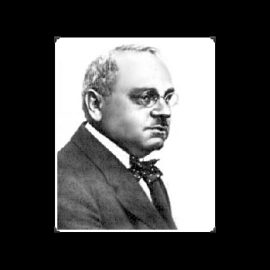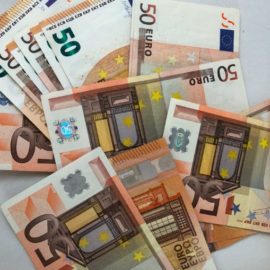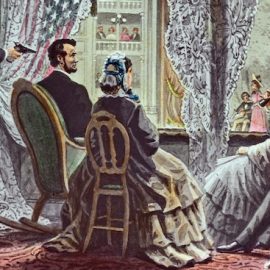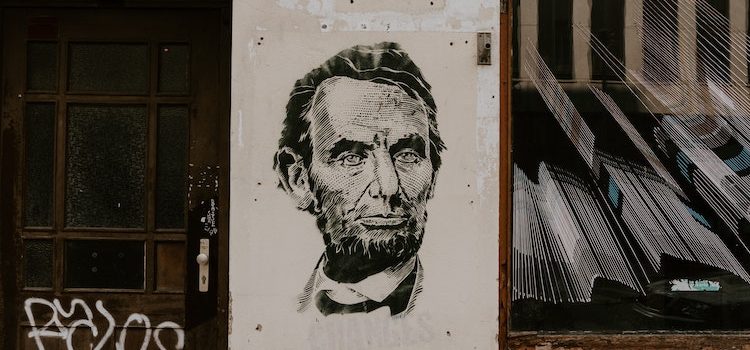
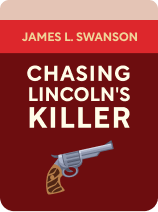
This article is an excerpt from the Shortform book guide to "Chasing Lincoln's Killer" by James L. Swanson. Shortform has the world's best summaries and analyses of books you should be reading.
Like this article? Sign up for a free trial here .
What does the book Chasing Lincoln’s Killer reveal about the hunt for John Wilkes Booth and the other assassins? Who were these killers? What ultimately happened to them?
Chasing Lincoln’s Killer is a book by historian James L. Swanson. The account is drawn from archival materials of the assassination of Abraham Lincoln on April 14, 1865, and the hunt for John Wilkes Booth and his co-conspirators.
Read more to get a snapshot of Chasing Lincoln’s Killer.
Chasing Lincoln’s Killer: A Compelling Story
Chasing Lincoln’s Killer draws on archival material and trial transcripts to create a vivid account of Abraham Lincoln’s assassination and the 12-day pursuit of killer John Wilkes Booth and his co-conspirators through Washington, D.C., Maryland, and Virginia. The book evokes the unique time of political division, grievance, and danger that threatened the Union in the immediate aftermath of the Civil War.
Warriors of a Lost Cause
In the spring of 1865, Abraham Lincoln was beginning his second term as president, and Washington, D.C. was starting to breathe more easily as the four-year Civil War wound down.
However, many rebels and Confederate sympathizers refused to give up the so-called lost cause of slavery and states’ rights, holding out hope of eventually winning. Washington and the surrounding countryside harbored numerous spies and supporters of the Confederacy looking for ways to undermine the Union.
One vehement anti-Unionist was a popular 26-year-old actor, John Wilkes Booth. Chasing Lincoln’s Killer describes Booth as a racist and a Lincoln-hater acquainted with Confederate agents and sympathizers from Canada and New York City to Virginia. In the spring of 1865, after General Robert E. Lee’s disappointing surrender, Booth became increasingly dismayed with Lincoln—and a belief took root that killing Lincoln would rally Confederate sympathizers and veterans to renew the fight and defeat the Union.
Planning the Assassination
Booth’s opportunity to kill Lincoln came on April 14 when he learned that the President and Mary Todd Lincoln would be attending the performance of Our American Cousin at Ford’s Theatre that evening. Having acted in other performances, Booth was familiar with the theater’s layout and knew he could shoot Lincoln in his balcony box and get away quickly.
However, Booth knew he’d need help because, in addition to killing Lincoln, he wanted to assassinate Vice President Andrew Johnson and Secretary of State William H. Seward. So at around 8 p.m. (curtain time for the play), Booth met with a group of co-conspirators at a hotel near the theater and assigned them roles.
Chasing Lincoln’s Killer reveals Booth’s co-conspirators and their roles:
1) David Herold, a tracker and outdoorsman, would guide conspirator Lewis Powell to Secretary of State Seward’s home in D.C. and wait while Powell killed Seward (Powell didn’t know his way around the city). Then Herold was to accompany Powell out of the city to meet up with Booth south of Washington, in Maryland, after Booth killed Lincoln.
2) Lewis Powell, a former Confederate soldier, would assassinate Seward, who was recuperating in bed at his home from a serious carriage accident.
3) George Atzerodt would kill Vice President Andrew Johnson in his room at the Kirkwood House hotel in Washington. Atzerodt had doubts about the assignment and didn’t sign on until Booth threatened him.
After the meeting, Booth checked on the progress of the play at about 9 p.m., then went to a nearby stable and got his horse, which he asked an unwitting theater employee to hold for him at the theater’s back door.
The Assassination Plot Unfolds
Booth returned to the theater at 10 p.m. and climbed the stairs to the balcony. In the vestibule leading to the president’s box, he pulled out a single-shot pistol and knife. He waited until there was just one actor on stage, who he knew would deliver a big applause line generating a reaction that would muffle his shot. He opened the door to the president’s box at 10:31 p.m., entered, and fired as he heard the applause line, striking Lincoln in the head. A guest in the box lunged at Booth, but Booth stabbed him and escaped by climbing over the balcony, dropping to the stage (breaking his leg), and racing through the wings and out the back door to his horse.
Meanwhile, when Powell tried to kill Secretary of State Seward at his home, he encountered fierce opposition from Seward’s family and staff. After stabbing Seward and others, he fled the house, only to find that Herold had abandoned him when the fighting broke out. Lost in the city, Powell slept in a tree for two nights, then eventually found his way to Confederate sympathizer Mary Surratt’s boarding house, which he’d visited with Booth before.
For his part, Atzerodt abandoned his assignment to kill Vice President Johnson, spent the night in his hotel room, then fled to a cousin’s house in Maryland.
Booth and Herold both got out of the city unimpeded and met up in Maryland. Their plan was to continue fleeing south to Virginia, a Confederate state, where they hoped to find support and acclaim. Early on, they stopped at the Maryland farm of Confederate sympathizer Dr. Samuel Mudd, who splinted Booth’s leg.
12 Days on the Run
As Lincoln died and Secretary of War Edwin Stanton launched an investigation and manhunt for the killers, Booth and Herold’s flight from Washington continued as follows:
- April 15-19: Booth and Herold rested at Mudd’s farm, then left that evening to connect with an ex-Confederate officer who would help them get across the Potomac River to Virginia. To avoid troops searching for Booth, they hid in the woods until nightfall on April 20, rather than staying at the officer’s farm.
- April 20-21: That night, a Confederate sympathizer led them to the river and a fishing boat. He showed them how to steer a course in the darkness to the other side. Booth and Herold got turned around in the darkness and rowed in the wrong direction. Early on April 21, they landed back in Maryland, farther north than they had been before. They stayed that night with a friend of Herold’s.
- April 22-23: Late on the night of April 22, Booth and Herold got back on the Potomac and crossed to Virginia, and in the early morning hours, they met another Confederate agent who took them to a doctor recommended by Mudd to check Booth’s leg. However, the doctor suspected their identities and refused to help them. They stayed at a nearby cabin after threatening the African-American man who lived there. The next morning, they paid him for use of a wagon and team and drove to Port Conway on the Rappahannock River, planning to get a ride across the river to Port Royal and catch a train heading south.
- April 24-26: At the Rappahannock, Booth and Herold encountered three Confederate soldiers, who agreed to help them get across the river and assist them on the other side. After landing, the men came upon a farm owned by Richard Garrett and asked to stay the night, claiming that Booth was a wounded Confederate soldier. Garrett allowed Booth to stay at the farm, while Herold and their three Confederate companions rode into the town of Bowling Green for lodging. The Garretts soon became suspicious of Booth and Herold and refused their request to stay another night. When the fugitives promised to sleep in the barn and leave the next day, the Garretts agreed—but they bolted the barn doors from the outside after Booth and Herold went to sleep.
Meanwhile, Powell and Atzerodt were both caught and arrested. Powell was arrested when he showed up at the Washington boarding house of Confederate sympathizer Mary Surratt (and Surratt was arrested as well due to her known ties to Booth and other conspirators). Atzerodt was arrested at his cousin’s house in Maryland after he aroused suspicions by joking that he’d killed Lincoln and confirming the attack on Seward, and another guest reported him to authorities.
Chasing Lincoln’s Killer details that Dr. Mudd was arrested after changing his story several times about the two men he had assisted (Booth and Herold) the night of the assassination. He claimed he didn’t know them, then said he eventually recognized Booth as someone he’d met previously.
The Fugitives’ Last Stand
After a tip from a witness who’d seen two men, one of whom had a broken leg, crossing the Rappahannock, the 16th New York Cavalry raced to Port Royal in pursuit. On April 26, the cavalry tracked down one of the fugitives’ Confederate helpers, who confessed to knowing Booth’s location. The cavalry then rushed to the Garrett farm.
Booth and Herold heard them coming up the lane, but when they couldn’t get the barn doors open, they realized they were locked in. The troops surrounded the barn, but instead of storming it, they tried to persuade Booth and Herold to surrender. Herold gave himself up, but Booth refused. The troops set the barn on fire.
A sergeant watching Booth through a gap in the wall boards saw him draw his pistol and also raise the Carbine held in his other hand as if to fire through the open door at the troops outside. So the sergeant aimed and fired his own pistol through the crack, striking Booth in the neck. The soldiers brought Booth outside, still hoping to take him back to Washington to face justice—but he’d been mortally wounded and died hours later as the sun rose.
Trial and Execution
On July 5, eight co-conspirators were tried and found guilty. The next day, four—Mary Surratt, Lewis Powell, David Herold, and George Atzerodt—were hanged. Mary Surratt was mistakenly believed to have played a central role in organizing the plot. Dr. Mudd was sentenced to prison—however, his sentence was commuted four years later by President Johnson, in part for his help during a prison epidemic. Mudd returned to his farm, where he died in 1883.
Chasing Lincoln’s Killer is condensed from a longer book to adapt it for young readers, but the compelling storyline and many lesser-known historical details about the hunt for John Wilkes Booth will interest adult readers as well.

———End of Preview———
Like what you just read? Read the rest of the world's best book summary and analysis of James L. Swanson's "Chasing Lincoln's Killer" at Shortform .
Here's what you'll find in our full Chasing Lincoln's Killer summary :
- A vivid account of Abraham Lincoln’s assassination
- The 12-day pursuit of killer John Wilkes Booth and his co-conspirators through Washington, D.C., Maryland, and Virginia
- A story that is condensed to be suitable for readers of all ages

